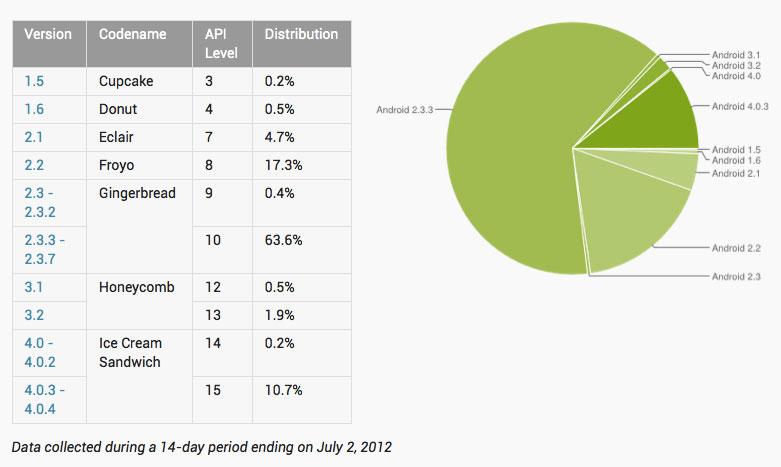8 months in, 11% of Android devices run 4.0 Ice Cream Sandwich
A developer information page provided by Google gives an extensive breakdown (via Business Insider) on devices that accessed the Google Play store in a two-week period ending July 2, 2012. It shows that just 10.9 percent of those users were running some form of Android 4.0 "Ice Cream Sandwich," the latest version of the operating system.
The lion's share of Android device users are still running some form of Android 2.3, also known as "Gingerbread." That version of the operating system was found on 64 percent of devices that accessed Google Play.
Google's website allows developers to decide how to prioritize development of application features, based on what the current Android usage patterns are. The data clearly shows that after 8 months of availability, Android 4.0 is still only found on a relatively small number of handsets.
In fact, more users are still running version 2.2 of Android. "Froyo" accounted for 17.3 percent of devices that accessed Google Play, according to Google.
Though adoption of Android 4.0 Ice Cream Sandwich is limited, Google is pushing forward with the next update to its mobile operating system, Android 4.1 "Jelly Bean." That software update will be released in July.
But as noted by The Verge, third-party device manufacturers have been largely silent as to when or if current devices will receive the upgrade to Jelly Bean. That means that only some of Google's own devices — the Galaxy Nexus, Motorola Xoom and Nexus S — will receive the update when it arrives in mid-July.
When asked what handsets will receive Jelly Bean and when it will become available, Acer, Asus and HTC all declined to comment, LG said it is evaluating the software update, and Samsung said a list of eligible devices is forthcoming.
The problem in providing updates is that third-party Android device makers develop their own "skins" to provide a unique user interface experience on their handsets. This allows the software and hardware on a handset to be differentiated from other options on the market.
But customizations to Android like HTC's Sense and Samsung's TouchWiz take time to create, and must be updated or overhauled every time Google provides its own updates to the Android platform. That means that legacy devices are often left behind, which is why a majority of Android handsets continue to run Gingerbread, which was released in December of 2010.
Apple doesn't publicly break down what versions of iOS iPhone users are running, but some third-party surveys have consistently shown that iPhone users are far more likely to update their handset to the latest operating system update. Last fall, just five days after the release of iOS 5, Chitika found that more than 20 percent of iOS devices it tracked had updated.
 Slash Lane
Slash Lane











 Malcolm Owen
Malcolm Owen
 William Gallagher and Mike Wuerthele
William Gallagher and Mike Wuerthele
 Christine McKee
Christine McKee
 William Gallagher
William Gallagher

 Marko Zivkovic
Marko Zivkovic









